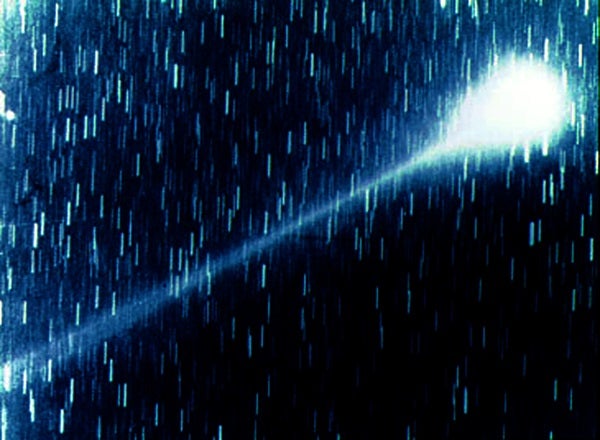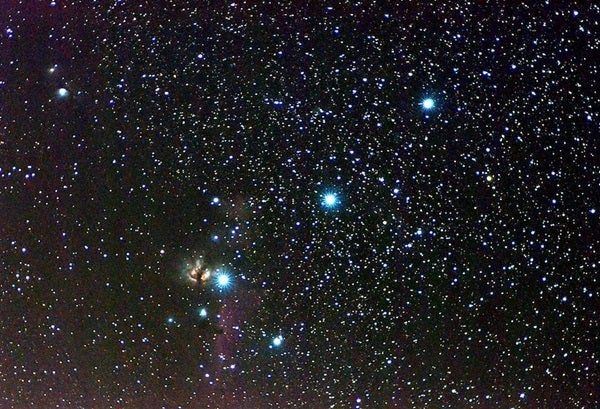Look high in the east after darkness falls this week and you should see autumn’s most conspicuous star group. The Great Square of Pegasus stands out in the evening sky at this time of year, though it appears balanced on one corner and looks more diamond-shaped. These four almost equally bright stars form the body of Pegasus the Winged Horse. The fainter stars that form the rest of this constellation’s shape trail off to the square’s west.
The Moon reaches perigee, the closest point in its orbit around Earth, at 6:27 p.m. EDT. It then lies 227,666 miles (366,392 kilometers) away from us.
Saturday, October 6
Asteroid hunters have a great opportunity to spot Vesta against the backdrop of northern Sagittarius this week. This evening, the magnitude 7.5 minor planet stands 0.4° southwest of 3rd-magnitude Lambda (λ) Sagittarii, the star that marks the lid of the constellation’s Teapot asterism. Tomorrow night, Vesta passes 0.3° due south of this star. And later this week, the asteroid slides 2° south of the 5th-magnitude globular star cluster M22.
Sunday, October 7
Comet 21P/Giacobini-Zinner currently glows at 8th magnitude, bright enough to see with binoculars from a dark-sky site and an easy target through a telescope. The periodic visitor resides in southern Monoceros, a region that climbs nearly halfway to the zenith as morning twilight starts to paint the sky. And this morning, the comet stands less that 1° north of the 6th-magnitude open star cluster M50. (The cluster itself lies 9° north-northeast of the sky’s brightest star, Sirius.) Giacobini-Zinner has a notable place in astronomical history because, in September 1985, it became the first comet visited by a spacecraft when the International Cometary Explorer flew past.
Monday, October 8
The normally minor Draconid meteor shower reaches its peak tonight. Although this typically wouldn’t raise observers’ expectations, this year could see a major rise in activity. That’s because the shower’s parent comet — 21P/Giacobini-Zinner — made its closest approach to the Sun in September, and previous outbursts have followed the comet’s return. With the shower’s peak coinciding with New Moon, viewers could see 10 or more meteors per hour coming from the constellation Draco the Dragon in the hours before midnight.
New Moon occurs at 11:47 p.m. EDT. At its New phase, the Moon crosses the sky with the Sun and so remains hidden in our star’s glare.
The Moon’s absence from the morning sky these next two weeks provides observers with an excellent opportunity to view the zodiacal light. From the Northern Hemisphere, the time around the autumnal equinox (which occurred 2.5 weeks ago) is the best for viewing the elusive glow before sunrise. It appears slightly fainter than the Milky Way, so you’ll need a clear moonless sky and an observing site located far from the city. Look for a cone-shaped glow that points nearly straight up from the eastern horizon shortly before morning twilight begins (around 5:30 a.m. local daylight time at mid-northern latitudes). The Moon remains out of the morning sky until October 23, when the waxing gibbous returns and overwhelms the much fainter zodiacal light.
Wednesday, October 10
Mars continues to put on a great show these October evenings. The Red Planet appears some 30° above the southern horizon once darkness falls. The world shines at magnitude –1.1, significantly brighter than any star visible on October evenings, against the faint backdrop of central Capricornus. A telescope reveals a disk that spans 14″ and shows several subtle surface features.
Thursday, October 11
Look low in the west-southwest after sunset and you’ll see a slender crescent Moon standing 4° above Jupiter. The pretty pair stands nearly 10° above the horizon an hour after sunset and sets shortly after the last vestiges of twilight fade away. Jupiter shines at magnitude –1.8 among the background stars of Libra the Scales. Although it is the brightest point of light in the sky, it lies too low to show much detail through a telescope.
Friday, October 12
The night sky’s most conspicuous harbinger of winter now rises in the east around midnight local daylight time. The constellation Orion the Hunter appears on its side as it rises, with ruddy Betelgeuse to the left of the three-star belt and blue-white Rigel to the belt’s right. As Orion climbs higher before dawn, the figure rotates so that Betelgeuse lies at the upper left and Rigel at the lower right of the constellation pattern.
Uranus reaches opposition in just 10 days, and it is already a tempting evening target. The ice giant world rises during twilight and climbs 30° above the eastern horizon by 9:30 p.m. local daylight time. The magnitude 5.7 planet lies in the southwestern corner of Aries, 10° due south of the Ram’s second-brightest star, 3rd-magnitude Beta (β) Arietis. Although Uranus glows brightly enough to see with the naked eye under a dark sky, binoculars make the task much easier. A telescope reveals the planet’s blue-green disk, which spans 3.7″.
Sunday, October 14
Saturn stands 1.5° to the left of the waxing crescent Moon this evening. The two lie 20° above the southwestern horizon at the end of twilight and remain on view until after 10 p.m. local daylight time. The ringed planet shines at magnitude 0.5 this week, more than a full magnitude brighter than any of the background stars in its host constellation, Sagittarius. If you own a telescope, there’s no better target than Saturn. Even the smallest instrument shows Saturn’s 16″-diameter disk surrounded by a dramatic ring system that spans 37″ and tilts 27° to our line of sight.












